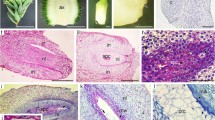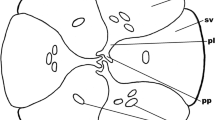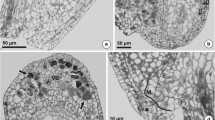Summary
Apogamety, the occurrence of which has been either denied or criticized by some authors, presents several problems that should be carefully considered in argumentation. Gynogenesis, which comprises zygotic, parthenogenetic, and apogametic embryos, an actively developing branch of tissue culture, is of no help here being itself subject to similar criticism. The discussion on apogamety awaits methodological progress which would yield answers to the following questions: are all cells of embryo sac potentially gametic; in what way are the mechanisms of cell differentiation and specialization of cells within embryo sac correlated with their totipotency; what are the limitations of plant cell totipotency in embryo sacs. The above problems of apogamety are not only an enigma for embryology and reproduction of angiosperms but they belong also to the crucial problems of the general biology which might be solved by studies of corresponding molecular mechanisms and experiments in tissue culture.
Similar content being viewed by others
References
Battaglia E (1963) Apomixis. In: Maheshwari P (ed) Recent advances in embryology of the angiosperms. Catholic Press, Ranchi, India, pp 221–264
Bohanec B (1994) Induction of gynogenesis in agricultural crops: a review. In: Proceedings of IPBA, Rogla, December 5–7, 1994, pp 43–55
Bossoutrot D, Hasemans D (1985) Gynogenesis inBeta vulgaris: from in vitro culture of unpollinated ovules to the production of doubled haploid plants in soil. Plant Cell Rep 4: 300–303
Chaubal R, Reger BJ (1992) Calcium in the synergid cells and other regions of pearl millet ovaries. Sex Plant Reprod 3: 34–46
Czapik R (1997) Theoretical aspects of apogamety in angiosperms. Bull Pol Acad Sci 45: 2–4
Cooper DC (1943) Haploid-diploid twin embryos in Lilium and Nicotiana. Am J Bot 30: 408–413
Favre-Duchartre M (1977) Eight interpretations of embryo sac. Phytomorphology 27: 407–418
Gerassimova-Navashina EN (1958) Gametophyte, basic developmental features and function of reproductive elements in angiosperms. Probl Bot 3: 125–167 (in Russian)
Gu S-R, Gui Y-L, Xu T-Y (1985) Induction of endospermal plantlets in Lycium. Acta Bot Sin 27: 106–108
Gustafsson A (1946) Apomixis in higher plants I: the mechanism of apomixis. Lunds Univ Arsskr Avd 242: 1–66
Huang Q-F, Yang H-Y, Zhou C (1982) Embryological observations on ovary culture of unpollinated young flowers inHordeum vulgare L. Acta Bot Sin 24: 296–300
Johanson A (1950) Plant embryology. Chronica Botanica, Waldham, Mass
Johri BM, Ambegaokar KB (1984) Embryology: then and now. In: Johri BM (ed) Embryology of angiosperms. Springer, Berlin Heidelberg New York Tokyo, pp 1–52
—, Ambegaokar KB, Srivastava PS (1992) Comparative embryology of angiosperms, vol 1. Springer, Berlin Heidelberg New York Tokyo
Kamelina O (1995) Synergid apogamety in the genusTetradiclis Stev. (Tetradiclidaceae) and occurrence of this phenomenon in flowering plants. Apomixis Newsl 8: 32–33
Li G-M, Yang H-Y (1986) Further embryological studies on the in vitro apogamy inOryza sativa L. Acta Bot Sin 28: 229–234
Liu Y-S, Sun J-S, Wang F-H (1994) Cytoembryological studies on polyembryonic line SB-1 ofOryza sativa: polyembryony and its origin. Acta Bot Sin 36: 821–826
Nakano H, Tashiro T, Maeda E (1975) Plant differentiation in callus tissue induced from immature endosperm ofOryza sativa L. Z Pflanzenphysiol 76: 444–449
Naumova TN, Yakovlev MS (1975) Development of embryonic structures inTrillium camschatcense Ker.-Gawl. after pollination. Bot Zh 60: 627–635 (in Russian)
Nogler GA (1984) Gametophytic apomixis. In: Johri BM (ed) Embryology of angiosperms. Springer, Berlin Heidelberg New York Tokyo, pp 475–518
Renner O (1916) Zur Terminologie der pflanzlichen Generationswechsel. Biol Zentralbl 36: 337–374
Rutishauser A (1967) Fortpflanzungsmodus und Meiose apomiktischer Blütenpflanzen. Springer, Wien New York
Schürhoff PN (1922) Zur Polyembryonie vonAllium odorum. Ber Dtsch Bot Ges 11: 374–381
Solntseva PM (1969) Principles of embryological classification of apomixis in angiosperms. Rev Cytol Biol Veg 32: 371–377
Solntseva PM (1995) Letters. Apomixis Newsl 8: 55–57
Srivastava PS (1973) Formation of triploid plantlets in endosperm cultures ofPutrajwa rox burghi. Z Pflanzenphysiol 69: 270–273
Tian H-Q, Yang H-Y (1983) Synergid apogamy and egg cell anomalous division in cultured ovaries ofOryza sativa L. Acta Bot Sin 25: 403–408
Yakovlev MS (1974) Gametogenesis, embryo sac and pollen grain (contribution to the problem of the origin of Angiospermae). Bot Zh 59: 1712–1727 (in Russian)
Author information
Authors and Affiliations
Rights and permissions
About this article
Cite this article
Czapik, R. Enigma of apogamety. Protoplasma 208, 206–210 (1999). https://doi.org/10.1007/BF01279091
Received:
Accepted:
Issue Date:
DOI: https://doi.org/10.1007/BF01279091




